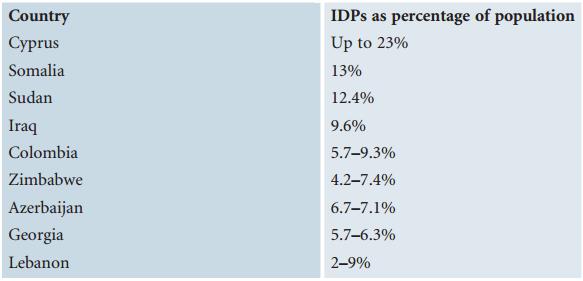“When people are forced from their homes but remain within their own country, they are known as Internally Displaced Persons (IDPs). The key characteristics of internal displacement are its coercive nature and the fact that affected populations do not cross an internationally recognized border”.
Retrieved from https://docs.unocha.org/sites/dms/Documents/OOM_InternalDisplacement_English.pdf on October 16, 2014
In the Guiding Principles on Internal Displacement, IDPs are defined as “persons or groups of persons who have been forced or obliged to flee or to leave their homes or places of habitual residence, in particular as a result of or in order to avoid the effects of armed conflict, situations of generalized violence, violations of human rights or natural or human-made disasters, and who have not crossed an internationally recognized State border.” The involuntary nature of their departure and the fact that they remain in their own country are the two main elements determining who is an internally displaced person.
The full document of the Guiding Principles on Internal Displacement can be found here: http://www.idpguidingprinciples.org/ [Accessed December 5, 2014]
“Internal displacement is a situation in which persons or groups of persons have been forced or obliged to flee or to leave their homes or places of habitual residence, in particular as a result of or in order to avoid the effects of armed conflict, situations of generalized violence, violations of human rights or natural or human or human-made disasters, and who have not crossed an internationally recognized state border”
Retrieved from http://www.internal-displacement.org/about-us on October 16, 2014
Elizabeth Ferris stated that presently, Iraqis who are trying to flee violence from their countries are sometimes unable to cross borders, and therefore, they seek safety within their borders (2008, p.80). “Lacking basic services such as food, water, sanitation, shelter, and medical care, the Iraqi Kurdish IDPs experienced high mortality and ongoing vulnerability to the threat attacks by Iraqi forces…” (Ferris, 2008, p.80-81). Disaster-induced displacement leaves a large number of people depending on food aid, medical supplies and other assistance from organizations both international and national (Oucho, 2005, p.3). Professor Oucho writes in his paper that epidemics are another cause for internally displaced persons i.e. HIV/AIDS that force patients to move from urban areas to rural areas in order to seek medical attention. Furthermore, natural and human-made disasters (wars, government conflict, etc.), increase mortality rates within IDP populations, as well as reduction in access to food, shelter, medical care, etc. (2005, p. 4).
In a brief article titled, “What is Internal Displacement?” a 2005 incident was stated in which a group of people from Khartoum, Sudan, were being forcibly relocated by Sudanese police (2010). “The Sudanese police attempted forced evictions of IDPs…Those who were relocated had urgent humanitarian needs…they had been forced out with few possessions, subjected to violence en route, and abandoned in empty wasteland in the desert” (OCHA, 2010). Furthermore, in 2011, Somalia was experiencing generalized violence, conflict between governments and groups, drought that led to famine in southern and central regions, and high rates of malnutrition resulting in IDPs between 1.4 and 1.5 million (Global Overview, 2011).

The data retrieved from Internal Displacement: Global Trends in Conflict-Induced Displacement, examines the countries with the most IDPs in 2008 (Birkeland, 2010, p.493).
Beau, C. & Jens-Hagen, E. (2004). The OSCE and internal displacement: a new momentum. Helsinki Monitor, 15(10, 13-22
Cohen, R. (2004). The guiding principles on internal displacement: an innovation in international standard setting. Global Governance, 10(4), 459-580
Ibeanu, O. (1998). Exiles in their own home: internal population displacement in Nigeria. African Journal of Political Science / Revuew Africaine de Science Politique, 3(2), 80-97
Kellenberger, J. (2009). The ICRC’s response to internal displacement: Strengths, challenges and constraints. International Review of the Red Cross, 91(875), 475-490
Powell, S., Rosner, R., Butollo, W., Tedeschi, R .G. & Calhoun, L. G. (2003). Posttraumatic growth after war: A study with former refugees and displaced people in Sarajevo. Journal of Clinical Psychology, 59(1), 71-83
Handbook for the Protection of Internally Displaced Persons. (2006). UNHCR. http://www.unhcr.org/4c2355229.html
Mooney, E. (2005). The concept of internal displacement and the case for internally displaced persons as category of concern. Refugee Survey Quarterly, 24(3), 9-26
Birkeland, N. M. (2009). Internal displacement: Global trends in conflict-induced displacement. International Review of the Red Cross, 91(875), 491-508
Ferris, E. (2008). Internal displacement and the right to seek asylum. Refugee Survey Quarterly, 27(3), 76-92
Oucho, J. (2005). Internal Displacement of Population in the SADC Region: An Overview. African Population and Environment Institute, 1-11.
People Internally Displaced by Conflict and Violence (2012). UNHCR: Global Overview 2011, retrieved from http://www.unhcr.org/50f95f7a9.html on October 13, 2014
Report of the Representative of the Secretary-General, Mr. Francis M. Deng, submitted pursuant to Commission resolution 1997/39, Addendum: Guiding Principles on Internal Displacement. (1998). UN Commission on Human Rights, 1-14
What is Internal Displacement? (2010) OCHA on Message: Internal Displacement. Retrieved from https://docs.unocha.org/sites/dms/Documents/OOM_InternalDisplacement_English.pdf on October 14, 2014.
Other Related Terms
- Refugees
- Borders
- Human Rights